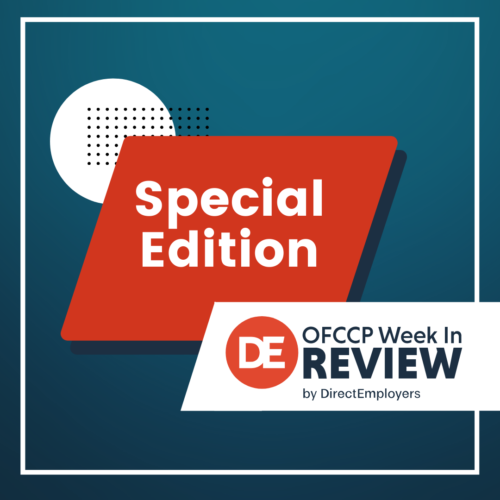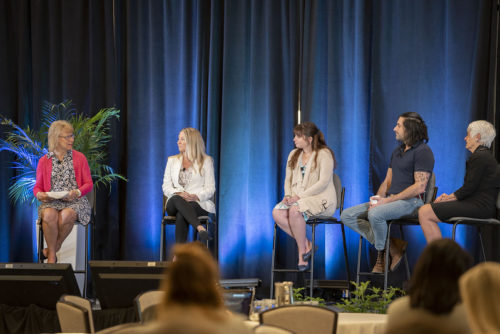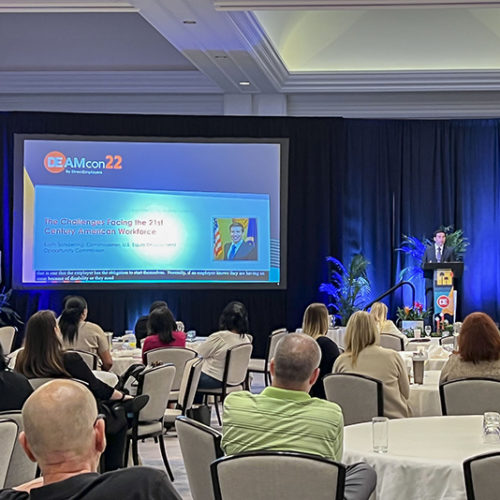
We hope you enjoy this tour of the DEAMcon22 conference and vicariously absorb some of the rich content of what many describe as the country’s most diverse and educational EEO meeting each year. And with warm thanks to Cyndi for joining our WIR team for this special event! Explore key sessions on day three:
- Panel Discusses Neurodiversity In The Workplace & Breaking Down Barriers
- EEOC Commissioner Sonderling Told DirectEmployers Annual Meeting Attendees The EEO-1 Component 2 Survey Will Soon Return
- HR Director Rises to the Challenge Of Implementing National HRIS At Decentralized Construction Company
- Attorney Explains How To Lawfully Use Race & Gender In The Selection Process
The final day of DEAMcon22 kicked off on a high note as Candee Chambers called the day to order, which began with a lively recap video of day one and day two of the conference – including footage from the Califor-neon Nights Party.
Panel Discusses Neurodiversity In The Workplace & Breaking Down Barriers
The final day of the conference started with a panel discussion, moderated by DE Executive Director Candee Chambers, on the significant talent opportunity of individuals who identify as Autistic or neurodivergent.
”Even if you don’t know it, you have a neurodiverse workforce. We all have different brains,” noted Attorney and Advocate Haley Moss. Joining Haley on the panel were: Susanne Bruyère, Professor of Disability Studies at Cornell University and the Director of the Yang-Tan Institute on Employment and Disability; Matthew Saleh, Research Associate at Cornell’s Yang-Tan Institute on Employment and Disability; and Tina Schmitt, Talent Acquisition and Retention Manager and Project SEARCH Business Liaison at the Kennedy Krieger Institute.

Responding to the question of, “How do you suggest that we help other employees understand?” Haley offered that she describes neurodiversity as working with people who are bilingual when she slips up with the “language barrier.”
“A lot of us are engaging in normative assumptions,” Matthew observed. “We really want to connect [hiring criteria] to what is important to the job.”
“Which means you need to recheck your job descriptions,” Haley added. Too often, the hiring process tests not so much who is good at the job, but who is good at this specific process, she noted.
Being accommodating is not just a legal process, Matthew stated. “It is a way of being and existing.”
If you give the message at the top of the organization that “this is part of our business initiative,” it sets up the mindset, Susanne stated. Matthew cited a study that found a career webpage is one of the most cost-effective ways to show people your message. Furthermore, the best websites go beyond just EEO statements at the bottom of the page and don’t use just one stock image. “You want real people,” he advised.
OFCCP has recommended that the CEO, and other executives, do videos, Candee pointed out. Susanne immediately confirmed that when employers do that, they hire significantly more people from this talent group.
Tina said that Project Search is the biggest program on which she has worked. It involves workers rotating through jobs to get a good match. Her personal favorite is a job audition rather than traditional interviews. “We might walk around and show them the people on the floor. We have to change those standardized practices,” she said.
“If companies have internships, they are six times more likely to hire persons with disabilities. Suzanne noted. “We can train like crazy, but we cannot forget to inform people.”
Candee noted that some organizations do not have people with disabilities on their board. “People just tend to think [diversity] is [limited to] race and gender.
She also pointed out that remote work can be an excellent accommodation. “You might want to think about how people are effected by going to the office; it doesn’t have to be a neurodivergent issue.”
However, Tina cautioned that “virtual interactions can also be problematic in terms of neurodiversity.”
Mathew noted that disclosure to employers “is very complicated, but if you hire more diverse people, you will have them as mentors in your organization. “
Susanne reported that research shows people are more likely to disclose if they see evidence that the employer wants people with disabilities in their workforce.
When Candee asked for final words of advice, the responses were:
Tina: “Hire with your head and your heart.”
Haley: “Time to get comfortable with being uncomfortable.”
Matthew: “Interrogate your idea about what is ‘normal.’”
Suzanne: “Feel empowered because you are really in a position to make changes in your organization.”
Editor’s note: Recruit Rooster specializes in recruitment marketing, and developing career websites with accessibility and inclusive hiring in mind. The Recruit Rooster Creative Services Team can guide employers one step further by planning, filming, and producing recruitment videos that help bring an employment brand to life.
 EEOC Commissioner Sonderling Told DirectEmployers Annual Meeting Attendees The EEO-1 Component 2 Survey Will Soon Return
EEOC Commissioner Sonderling Told DirectEmployers Annual Meeting Attendees The EEO-1 Component 2 Survey Will Soon Return
We covered EEOC Commissioner Keith Sonderling’s Keynote presentation at length last week in our Week In Review published Monday April 25, 2022 which you may find here.
HR Director Rises to the Challenge Of Implementing National HRIS At Decentralized Construction Company
Ashley Valenzuela-Ruesgen, Director of Human Resources at Hensel Phelps Construction Co shared how she successfully spearheaded the effort to move her employer — an 85-year-old construction company that previously never even had an HR department — from theory to implementation of a human resources information system (HRIS) on a national scale.
The employer, a U.S. Department of Defense contractor, had made the intentional decision for 85 years to not have an HR department. Yet, “[w]hat’s working today isn’t necessarily going to work for tomorrow,” she said.

One big challenge was the company’s decentralized organization. Because it did not have a Talent Acquisition function, they had over five hundred people in the recruiting function. Therefore, she had to take the Talent Acquisition Managers (TAMs) and bring them along. She recognized that she had to balance the autonomy of the company’s regions with the need for compliance consistency. Moreover, she was determined to prove that it wasn’t just a cost exercise.
She concluded her presentation by telling the audience to remember the following factors for success: future envisioned state; change champions; executive sponsorship; process owners; business alignment; and “your why.”
Attorney Explains How To Lawfully Use Race & Gender In The Selection Process

There are two rules sometimes cited in efforts to increase diversity. First, the Rooney Rule, adopted by the NFL in 2003, is the policy that each team in the league consider minority applicants for head coach and upper-level coaching positions. Second, the Mansfield Rule, which was inspired by the Rooney rule and applies to law firms, legal departments, and companies, requiring them to consider protected groups for at least 30% of promotional opportunities.
Tension Between EEO and Affirmative Action
Yet, there is a tension between the legal requirement to make employment decisions that are not based on protected factors and the desire to ensure unrepresented groups are fully considered in the employment process. AAP Placement goals (41 CFR §60-2.16(e)(2)) do not provide the contractor with a justification to extend a preference to any individual, Cara noted. Likewise, the EEOC says in its Compliance Manual that employers cannot use race/gender in the selection process. Nevertheless, the U.S. Supreme Court ruled in United Steelworkers v Weber (1979) and Johnson v Transportation Agency, Santa Clara County (1987) that employers may develop voluntary AAPs in certain circumstances.
Legally Permissible Voluntary AAPs
Cara noted three lawful bases for voluntary AAPs. First, employers may take affirmative action if an analysis shows actual or potential adverse impact caused by existing or contemplated practices (29 CFR §1608.3(a)). Second, employers “may take affirmative action to correct the effects of prior discriminatory practices,” which “can be initially identified by a comparison between the employer’s work force, or a part thereof, and an appropriate segment of the labor force” (29 CFR §1608.3(b)). Third, “Because of historic restrictions by employers, labor organizations, and others, there are circumstances in which the available labor pool, particularly of qualified minorities and women, for employment or promotional opportunities is artificially limited” (29 CFR §1608.3(c)).
Under EEOC Guidelines, voluntary AAPs must contain three elements: (1) Reasonable self-analysis; (2) Reasonable basis for concluding action is appropriate; and (3) Reasonable action (29 CFR §1608.4). Moreover, voluntary affirmative action without a plan or program will not satisfy the EEOC guidelines. Such a plan must be a concerted and reasoned program, rather than a series of isolated events. In addition, employers will not receive the benefits of Guidelines and affirmative defense without the plan.
Cautionary Notes When Considering Voluntary AAPs
Cara then offered examples that satisfy the necessary criteria referenced above. She cautioned that voluntary AAPs should not contain: quotas; specific numerical objectives; specific dates for achievement; discharge of employees and replacement with covered persons; and an absolute bar.
Finally, Cara recommended that employers considering voluntary AAPs follow EEOC guidelines to the letter, and they must not forget to consider state and local laws.
THIS COLUMN IS MEANT TO ASSIST IN A GENERAL UNDERSTANDING OF THE CURRENT LAW AND PRACTICE RELATING TO OFCCP. IT IS NOT TO BE REGARDED AS LEGAL ADVICE. COMPANIES OR INDIVIDUALS WITH PARTICULAR QUESTIONS SHOULD SEEK ADVICE OF COUNSEL.
SUBSCRIBE.
Compliance Alerts
Compliance Tips
Week In Review (WIR)
Subscribe to receive alerts, news and updates on all things related to OFCCP compliance as it applies to federal contractors.
OFCCP Compliance Text Alerts
Get OFCCP compliance alerts on your cell phone. Text the word compliance to 55678 and confirm your subscription. Provider message and data rates may apply.
About the Guest Author


 EEOC Commissioner Sonderling Told DirectEmployers Annual Meeting Attendees The EEO-1 Component 2 Survey Will Soon Return
EEOC Commissioner Sonderling Told DirectEmployers Annual Meeting Attendees The EEO-1 Component 2 Survey Will Soon Return
